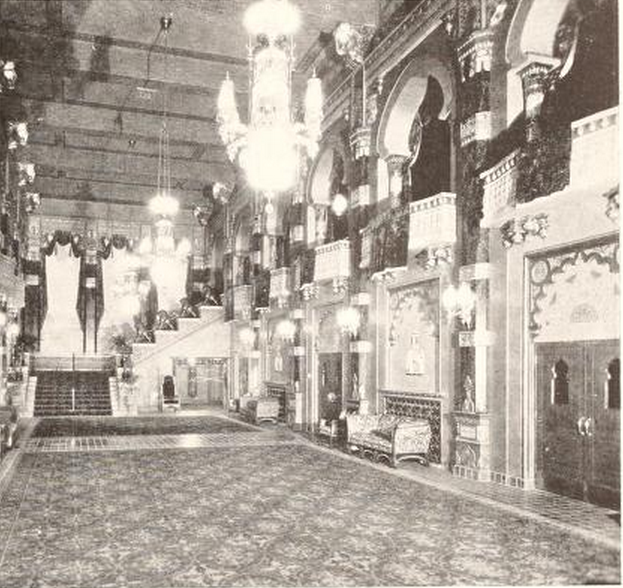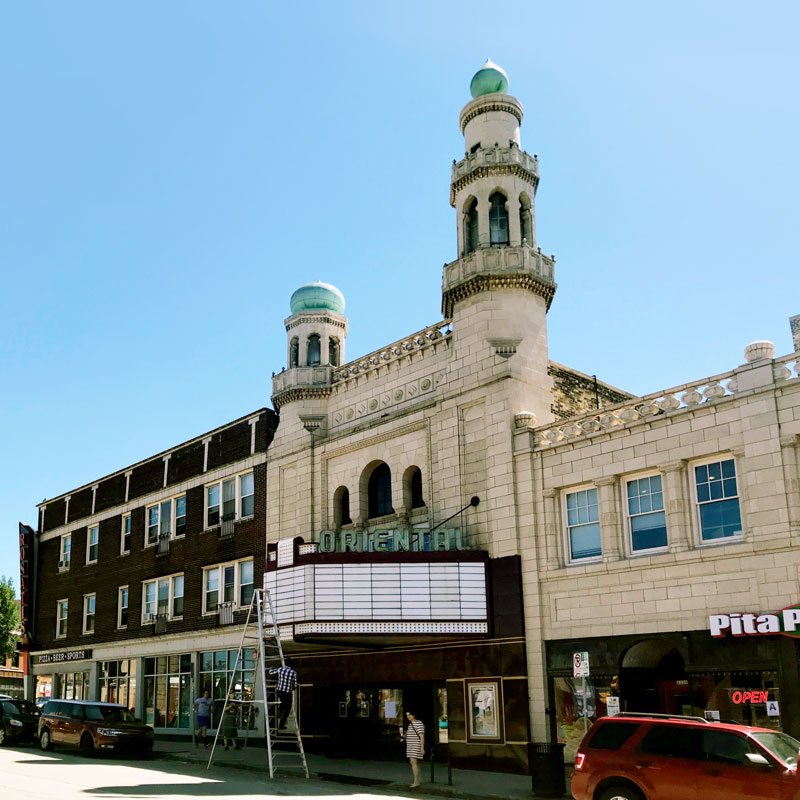This week, Milwaukee Film will reopen the Oriental Theatre, 2230 N. Farwell Ave., after spending six weeks cleaning and repairing Milwaukee’s most beautiful movie palace — and the only one still operating as a cinema — readying it for its latest role as the official home to the Milwaukee Film Festival, as well as year-round indie, foreign and art house films.
That Milwaukee Film assumed control of the theater – which was designated a city landmark in 1972 – on July 1 this year felt especially rewarding considering the very next day, the Oriental celebrated the 91st anniversary of its opening night on July 2, 1927.
The group has a 31-year lease on the Oriental.
"It’s so exciting to know that we will be here [in 2027] to celebrate the 100-year anniversary of the Oriental," says Emily Foster of Milwaukee Film, as we stand in the lobby, gazing up at the splendor.
We’re here to take a fresh look at the Oriental and we left almost no stone unturned …
Early history
The Oriental Theater was built by the Saxe Brothers Amusement Enterprises and designed by architects Gustave A. Dick and Alex Bauer, who also designed the Tower and Garfield Theaters for the local chain founded in 1902 by two Irish-born brothers, former one-time newsboys John and Tom Saxe.
Among the numerous other theaters Dick & Bauer also designed were the National, the Colonial, the Milwaukee, the Orpheum in Oshkosh, the Appleton in Appleton, the Capitol in Racine and the Sprague in Elkhorn.
By the time the theater was complete, the Saxe Brothers had built a sprawling empire of 42 cinemas, with nine more under construction and six more planned for the following year.
The land upon which the theater was built was originally home to Farwell Station, which was a streetcar barn and stables for the horses and mules that, since 1860, had lugged the conveyances around the city before electricity replaced them.
The depot remained a streetcar hub until the mid-1910s, when the land was sold to construction firm H. Schmitt & Sons, which moved there from its previous home on 26th and Townsend. In 1926, Schmitt built itself a new home in Riverwest and sold the Farwell land — the entire block west of is now Black Cat Alley — to Moses Annenberg. Yes, the Annenberg of the Annenberg Foundation.
Annenberg had left Milwaukee for New York City in 1920 when he became publisher of the New York Daily Mirror. But he retained his ties to Cream City and when he developed the land by leasing it to the Saxe Brothers, he became a partner in a major business in the new building.
He and partner Louis Bensinger opened Bensinger’s Recreation, with bowling lanes and billiards on the lower level. You can read more about the history of what became Landmark Lanes here.
Up above, Dick and Bauer created a theater which, according to "Silver Screens: A Pictorial History of Milwaukee’s Movie Theaters," by Larry Widen and Judi Anderson, was "considered by Saxe AE to be the crown jewel in the empire, (and) was touted as the city’s ‘premier movie temple.’"

Interestingly, it was H. Schmitt and Sons who built the theater that replaced their headquarters (as well as the Tower Theater a year earlier).
"[The Oriental] was the most elegant of the five new Saxe theatres (Uptown, Plaza, Garfield, Oriental and Tower), modeled after a Viennese opera house. The Tower had a Mediterranean feel and was somewhat of a sister theater to the Oriental, but it was not nearly as lavish. The Oriental, which opened in July 1927, cost $1.5 million, three times as much as the Tower, and the differences showed.
"At Saxe AE’s urging, Dick and Bauer conceived an elaborate and mystical theater that incorporated elements of East Indian, Moorish, Islamic and Byzantine architecture to create what they called, ‘the most beautiful and artistic temple of Oriental art to be found anywhere in America.’"
In addition to seating for 2,350 (or 2,500 or 2,110, depending on who you ask), and an astonishingly elaborate lobby — to say nothing of the ornate interior of an auditorium few would ever get enough illumination to see! — the Oriental boasted a large orchestra pit and attached backstage room, six dressing rooms above the stage and a lighting panel that was deemed second only to the one at Radio City Music Hall and on par with The Roxy in New York City.
The decor was — and still is — a quirky mix of styles that does not suggest a strong understanding of Eastern cultures on the part of Americans in the early 20th century.
Part East Indian, part Middle Eastern, there are Islamic-style minarets on the outside and Buddhas will glowing jewels on the inside.
There are representations of elephants and lions everywhere, as well as murals — designed by Chicago artist, credited in a newspaper report as "Mr. Thomas" — featuring mosques as seen on Turkey’s Strait of Dardanelles.
Though designed by Thomas, it's not a given that he painted the scenes.
The George Hamilton Thomas Studios Company, located at Tree Studios on State Street in downtown Chicago, did many such murals in the 1920s, according to Richard Grell of The Louis Grell Foundation, whose great uncle Louis Grell — also based at Tree Studios — painted some of the theater art that emerged from Thomas' studio. Grell also painted the murals at the Warner Grand Theater on 2nd and Wisconsin, which is being renovated into a new home for the Milwaukee Symphony Orchestra.
"On several Grell commissions, Thomas is wrongly credited because the local folks only knew who the ‘company’ was that had the contract. They were likely painted in Chicago and shipped there to be installed by local artisans."
Much of the sculpture work was done by German-born Milwaukee artist Anthony Spalthoff, whose work can also be seen in The Pabst and Riverside Theaters.
The fabrics in the theater — draperies, carpets, etc. — and the furniture, much of which survives, came from Gimbels. Charles Polacheck & Bro. Co. provided the unique light fixtures throughout the building.
"To describe the various chandeliers used in different locations would occupy too much space and they must be seen to be appreciated," wrote the Milwaukee Sentinel in 1927 and that remains true today.
"The fixtures … are all of special design, made to harmonize with the Oriental character of the architecture and decoration. East Indian idols, elephants and other distinctive symbols which are a mark of the East Indian styles are used in profusion."
Interestingly, the theater — described in a 1927 ad as a "modern brick, steel and reinforced concrete building containing a theater with seating capacity of 2,350, a garage, recreation parlor, offices and stores" — cost more to build than it was valued at when it opened.
Building costs
$1.5 millionFinal valuation
$976,285The difference, I guess, is the price of beauty.
Opening day
As the theater was prepared for its big opening on Saturday, July 2, 1927, Tom Saxe spoke to reporters, noting that the design motif was based on research undertaken by the architects, and that Jack Plant — who had previously run the Merrill Theater Downtown and then the Modjeska on Mitchell Street for Saxe Brothers — had been tapped as manager of the elaborate new movie house.

But, mostly, he boasted about the climate control system, which can still be seen in the basement of the theater today.
"The Oriental," Saxe told the Journal, "is equipped with a $175,000 ventilating system that floods the theater with 25 tons of pure air in the course of a day. This air can be chilled for summer comfort or, during winter months, heated to any desired degree."
It must’ve been quite an impressive system for its time, because journalists who attended the three shows on opening night — at 6:30, 8:30 and 10:30 p.m. — also commented on it.
The plan for the theater was to open a new "program" three times a week — for 40 cents admission — but for opening day, the feature film was the risque-sounding 70-minute silent picture "Naughty But Nice," starring Colleen Moore.
Also on the bill were "several feature acts" in a "de luxe stage presentation" called "Mystic Araby," including Arthur Corey (billed earlier in the decade as "Chicago’s phenomenal boy dancer"), Gauthier Sisters, Vaudeville comedian Eddie Willis, "acromusical clowns" the Novelle Brothers — who would do pantomime, as well as play the violin while doing flips — and Eddie Gailbreth.
There were also newsreels, a Felix the Cat cartoon (which ended the program), a performance onstage by Billy Adair and His Arabian Knights orchestra and a performance by Bernard Cowham on the theater’s new 3/14 Barton organ.
Incidentally, the Oriental also opened with not one but two new Steinway pianos, "the instrument of immortals," likely acquired from the piano studio of Edward Gram Downtown on Milwaukee Street.
Along with a handful of other stars, including Greta Garbo, Colleen Moore sent a telegram in advance of the opening.
"Hearty congratulations on the opening of your new Oriental Theater," she communicated in her missive, "an event that perhaps has created as much interest on the west coast as in Milwaukee. I am delighted that my latest picture was selected for the opening, and trust that the people of Milwaukee will get as much enjoyment out of seeing it as I did in making it."
According to a report in the Journal the day after, nearly 9,000 turned out for the three shows to check out the amazing new palace of entertainment.
"The Oriental is a remarkably handsome theater, its lobby is probably the most beautiful of any in the state and the appointments were praised by everyone," wrote an unnamed journalist. "The show given Saturday was heartily applauded by everyone."
One of the attendees, however, was especially notable, according to the paper.
Neighborhood Ald. William I. Greene, the paper reported, "enjoyed the show." And that was newsworthy because?
Well, it was the alderman’s first-ever moving picture show. Not that he was defensive about it or anything.
"I just don’t care to go," Greene was quoted as saying. "I haven’t any particular reason. I have never given it much thought to the fact that I haven’t seen a moving picture. What of it?"
Indeed.
"And then they built the Oriental … less than a block from the East Side Bank, of which Mr. Greene is president," wrote the reporter, "and in the center of a business district in which he is very much interested. … Mr. Greene accepted an invitation to be present at the opening performance and he remained until the end of the show."
When asked if the experience transformed him into a film fan, Greene replied, "Well, yes,’ he said. ‘It is handy now, you know, and one can find parking space around here. Besides, I have never been averse to moving pictures. It just happened that I never went to one."
Next on the calendar was John Barrymore in "Don Juan" and after that, Clara Bow in "Children of Divorce," both silent. The Oriental, it seems, wasn’t afraid of potentially edgy film content even back then.
Life goes on
Not long after the Oriental opened, the Saxe brothers sold their empire to Wesco Corporation. That’s because, according to Widen and Anderson, "with the success of their theaters, Saxe Amusement Enterprises was a highly sought after commodity. In December 1927, Saxe AE sold all of its theater leases for $2 million to Wesco. … Within six months after the sale, Wesco was purchased by the Fox Film Corporation, later known as 20th Century Fox. With its purchase of the Saxe chain, Fox controlled exhibition rights in 60 Wisconsin theaters, more than half in Milwaukee."
But in 1942, Warner took control of a number of Milwaukee theaters, including the Oriental, according to "Silver Screens."
The Pritchett family bought the building in 1972 and Landmark Theatres, a national art house chain, bought the lease in 1978 and ran the theater until June 30 of this year, having transitioned from the artsy, monthly calendar of ever-changing double-features into something of a mainstream cinema.
Though sister theaters, the Garfield and the Tower, still survive, it’s been years since they’ve operated as cinemas. The same is true of the Warner Grand and the Riverside. The Avalon is open now, but after having been closed for many years.
So, how is it that the Oriental has survived?
"The theater stayed profitable through the years, unlike its cousins," wrote Widen and Anderson. "Perhaps the main reason for the Oriental’s stability is that after World War II, the neighborhood did not undergo the same kind of transition" as other areas.
"The Oriental’s east side neighborhood … managed to continue to sustain restaurants, nightclubs, stores and entertainment venues. The Oriental survived the television craze of the 1950s and the shopping mall theater mania of the 1960s."
Today
However, by the 1980s, the idea of running a single-screen theater was becoming unmanageable and in 1988, two smaller theaters were carved out of the back corners of the Oriental auditorium and this helped the theater continue to weather changes in the industry.
And, now, the Oriental holds the world record for most continual screenings (performances, really) of "The Rocky Horror Picture Show," which debuted in January 1978.
The original organ was replaced in 1990 with a 3/32 Kimball, removed from the Warner Grand Downtown — that was used for performances by a local theater organ society — which was the largest of its kind in the country. That instrument was recently sold and removed.
Thankfully, the addition of the new theaters was done in a sensitive way and the Oriental looks no less splendiferous today, with its terra cotta facade, lorded over by a pair of minarets of varying heights and its familiar garnet-colored street-level cladding.
Inside, the tile — which, along with the lions, were made by Milwaukee's Stark Mantle & Tile Co. — is all there, and so are the Buddhas with the illuminated rubies in their foreheads, the baboons with glowing green eyeballs, the lions standing watch over the stairs up to the mezzanine and the "grand promenade" toward the ladies’ lounge.
Though the plaster needs work — damaged sections have been repaired and a full restoration is on Milwaukee Film’s to-do list — and so do the balcony seats, bathrooms on the main floor have been added and expanded and made handicapped accessible (and, thankfully, the complicated and distinctive floor tile has been replicated for the new spaces).
The sound system is being upgraded and the screen replaced, and, really, that’s just the beginning. The whole theater is undergoing a transformation, but one that you’ll feel in terms of upgrades, but won’t likely see.
"We’re working with some great partners to make sure that all the details are not left behind," Milwaukee Film’s Chief Marketing Officer Sara Meaney told me last month. "There is nothing more important to us than preserving the experience in a film palace like this. The goal is to make all the things that people love about it not just as great but better.
"When you fall in love with this this theater, the goal isn’t to change it; it’s to fix it so it can stay that way for a lot longer."
That means some of the great little Easter eggs will remain, too. Like George Harrison’s face in the carpet (there are faces everywhere in the carpet, but some are more John Oates or Kenny Loggins than the one in the lobby that looks like the late ex-Beatle). And like the one mismatched section of floor tile, also in the lobby.
Behind the scenes
On the occasion of the reopening, the kind folks at Milwaukee Film offered to let me see behind the screen once again. I was lucky enough to do this once as photographer on a story that Molly Snyder wrote for OnMilwaukee eons ago, but those photos have long since disappeared into the ether.
However, I’m sharing new ones here, so that you, too, can appreciate the inner workings of Milwaukee’s most enduring and beloved movie palace.

















































